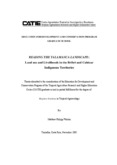| dc.description.abstract | Se estudiaron los factores que influyen en el uso y manejo de suelo por hogares Bribrí y Cabécar de Talamanca y el impacto de políticas, instituciones, y procesos (PIPs) en las estrategias de medio de vida de los hogares. Se definió una gradiente que abarcaba elevación y ecología del paisaje, distancia al mercado, acceso a infraestructura y la homogeneidad cultural. Influencias dominantes sobre el uso de suelo eran las 'reglas del juego' establecido por los organismos de certificación, compradores de productos orgánicos, y la red de intermediarios de plátano. La predominancia de plátano en ambas zonas dependía del establecimiento del mercado de plátano históricamente antes del mercado de productos orgánicos. Otros factores que influyeron en el dominio de plátano eran la dificultad por parte de productores a cambiar de plátano a Producción orgánica de banano debido al uso de agroquímicos y también los costos de oportunidad en la transición de Producción convencional a orgánica. La investigación también revelo que la integración al mercado y condiciones ecológicas influyeron en el diseño y el manejo del agroecosistema. Además, los ingresos fuera de finca, por ejemplo, la venta de labor del hogar, caracterizaba estrategias de vida en todas las zonas. This work examined factors influencing land use and management by Bribri and Cabécar households ot Talamanca and the varying impact of policies, institutions, and processes on their livelihood strategies. The present study sampled purposefully along a gradient to represent different degrees of remoteness from the market and public infrastructure and services, ecology, and cultural homogeneity. Dominant influences on land use were the different 'rules of the game' established by certification bodies and organic organizations and the network of plantain buyers, respectively. Predominance of plantain in both zones was due to the early historical establishment of the plantain market relative to the organic banana market. Further factors reinforcing this situation in which land use was 'locked' into agrochemical plantain production were the inability of plantain farmers to switch to organic banana production due to local agrochemical use, as well as the opportunity costs implied in the transition from conventional to organic production. Research revealed that both market integration and ecological conditions powerfully affect the design and management of the agroecosystem. Off-farm income, for example, from the sale of household labor, characterized livelihood strategies in all zones. | es_ES |


